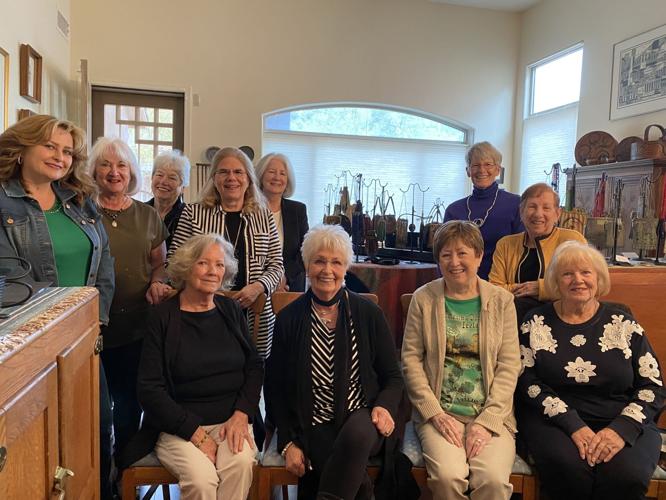Purses with Personality (Leather, Beaded and Mesh Purses 1880’s to 1930’s) were introduced to members of the Questers Catalina Timewalkers by Sylvia Munsen, hosting the March business meeting on Friday, March 15. Sylvia has a vast collection of these remarkable purses that members were treated to see. One may have seen these stunning accessories worn in TV vintage productions and movies such as “Downton Abbey”, “The Great Gatsby” and the “Roaring Twenties”.
Following the business meeting, Sylvia had a PowerPoint presentation showcasing the history of these purses, some quite endearing, having been owned by family members, purses belonging to cousins and one with seed pearls, Sylvia used at her prom. She also showed a leather tooled monogramed wallet belonging to a cousin of her grandmother in 1890, and her grandmother’s amazing cloche hat from 1920, intricately embellished with silver and gold beads, threads and gemstones.
Characteristics of beaded purses in the late 19th/early 20th centuries include the condition and method of construction, intricacy and rarity of the pattern, overall size of purse, presence/absence of lining, quality/uniqueness of frame, skill of bead worker, color scheme, complexity of fringing and personal appeal.
These exquisite, beaded purses were intricately fabricated with embellishments of bugle beads, (thin lengths of glass), cut steels in general, and French cut steels, gems, glass, seeds, pearls, pony (first transported by traders with pony packs) and sequins.
Manufacturer Wade David & Co., Massachusetts, introduced in 1892, a ring mesh or chainmail made with gold or silver, or German silver-wire soldered rings attached to a frame. Charles A. Whiting and his partner Edward P. Davis acquired the company, and it was renamed Whiting & Davis Co.
Whiting & Davis purchased all Dresden mesh machines in 1916 which produced very fine mesh; those fine mesh bags from around the 1920s to 1930s ranged in value from $5 to $37 each.
During the 1920s, Whiting & Davis bags were being ‘painted’ with colorful Art Deco and geometric designs and became a popular accessory for flappers, starlets of the silver screen and fashionable ladies of the time. Artists and designers like Paul Poiret and Elsa Schiaparelli lent their creative touch to the collections. Poiret was a well-known couture designer in France and created a Parisian-inspired collection of Art Deco handbags lined with silk.
Mandalia, a Turkish manufacturer, set up business in Boston, and patented his vintage purses in 1924. Known as Mandalian bags, they were well known to serious collectors. The company developed “Lustro Pearl” (looked like enamel), and those bags cost twice as much as Whiting & Davis bags.
Following the PowerPoint presentation, Sylvia’s co-hosts, Leni Bowman and Alice Dahl, served a buffet of delicious casseroles, cupcakes and fresh fruit accompanied with tea and coffee.
The real reason for needing a purse was not motivated by shopping, but by social interaction. A lady would visit her friends in the afternoon, leaving calling cards upon her arrival, and for evening social events like attending dances. Carrying cards, pencil, lipstick and a handkerchief in a small purse was not only convenient, but with some, showed off her handicraft talents as well.
Interested in joining the Catalina Timewalkers chapter of Questers? Meetings are usually held the third Friday of the month (October to May).
For Membership information, or to obtain a brochure, email Kipi Martin at martin.kathryn5@gmail.com.
The upcoming Arizona State meeting was held here in Tucson on Wednesday, April 17 and Thursday, April 18.
Meeting and Questers purpose, mission and vision information can be found at azquesters.org.




